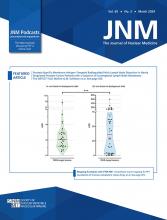REPLY: We thank Dr. Guglielmo and Dr. Evangelista for the great summary and thoughtful comments regarding our paper (1). We agree that there is still much to discover regarding the role of fibroblast activation protein (FAP) inhibitor (FAPI)–based radiotracers in hematology—for example, the relationship between FAPI avidity and prognosis and the correlation of heterogeneous and relapsed or refractory lymphomas.
Several recent studies have revealed the distribution of fibrosis in nodular sclerosis Hodgkin lymphoma, follicular lymphoma, and diffuse large B-cell lymphoma (2–4). We accidentally found that primary gastric lymphoma could accumulate 68Ga-labeled FAPI, which highlighted that 68Ga-FAPI is not cancer-specific (5). Most aggressive lymphomas were FAPI-avid, whereas indolent non-Hodgkin lymphoma lesions showed weak FAP staining and mild to moderate 68Ga-FAPI uptake (6). These results are partially consistent with the result of Tataroglu et al., which provided quantitative information about the amount of fibrosis in lymphoma lesions (2). The focus is now to determine which is the superior method, 68Ga-FAPI PET/CT or 18F-labeled FDG PET/CT in indolent lymphoma. Compared with FAP expression in stromal cells, glycolytic markers with high cell density were overexpressed in tumors and the tumor microenvironment, resulting in higher rates of detecting lymphoma lesions. However, our result was not very convincing because of the limited number and heterogeneity of patient population, especially the indolent type.
The ability to detect fibrosis before and after treatment with 68Ga-FAPI PET/CT could be the basis for planning prospective studies compared with treatment with 18F-FDG PET/CT. A prospective study showed that the presence of tumor sclerosis was significantly associated with poor overall survival of patients with advanced-stage nodal follicular lymphoma (7). As Dr. Guglielmo and Dr. Evangelista suggested, a large-scale, well-defined, prospective study should be designed in a homogeneous group to explore the potential role of 68Ga-FAPI PET/CT and the relationship between PET performance, heterogeneity, and prognostic value before and after treatment.
Malignancy theranostics is a novel approach that combines diagnostic imaging and radionuclide therapy. Only a few proof-of-concept studies have been published for FAP-targeted radioligand therapies, radiolabeled with 131I, 90Y, and 177Lu, which showed mixed responses (8–10). It is valuable to explore the role of FAP-targeted radionuclide therapy in refractory lymphoma patients, especially in aggressive lymphomas. Also, combination therapies of FAP-targeted radionuclide therapy and immunotherapy could be explored in relapsed or refractory aggressive non-Hodgkin lymphoma.
Overall, FAPI-based imaging and theranostics have been a highly vibrant research field over the past few years and have been the vanguard of personalized medicine. Beforehand, future larger-scale studies should be conducted to explore the diagnostic and therapeutic value of FAPI-targeted imaging and theranostics in hematology. We hope that our study arouses some interest in this research field.
Xuetao Chen, Xuejuan Wang*
Peking University Cancer Hospital and Institute, Beijing, China
*E-mail: xuejuan_wang{at}hotmail.com
Footnotes
Published online Feb. 1, 2024.
- © 2024 by the Society of Nuclear Medicine and Molecular Imaging.
REFERENCES
- Received for publication December 25, 2023.
- Accepted for publication January 11, 2024.







